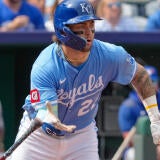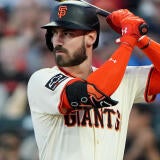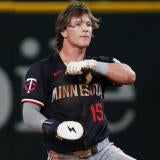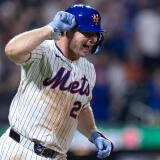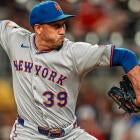
The toughest players to rank at second base for 2026: Ketel Marte, Jazz Chisholm, and other rising challengers
Second base features a massive struggle between safety and potential upside
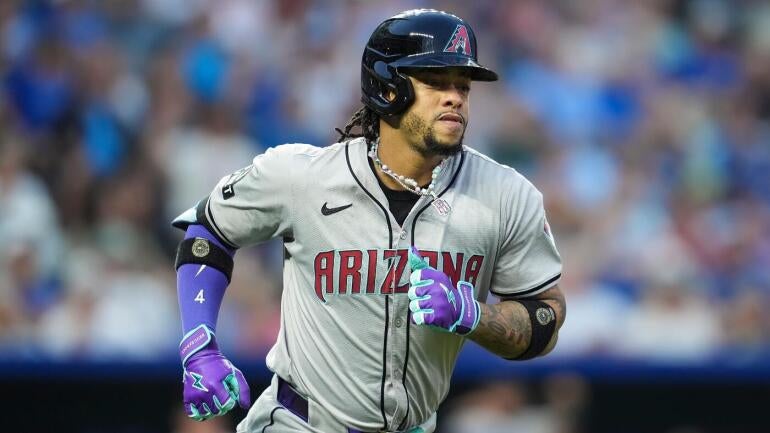
Who do you want as your top second baseman for 2026? In one corner, you've got Ketel Marte, who has re-established himself as the position's premier hitter over the past couple of seasons, one of the only second basemen capable of leading the position in both homers and batting average. In the other, you've got Jazz Chisholm, the Yankees dynamic star who is never going to sniff a batting title but who has emerged as the position's clear best power/speed threat.
In some ways, it's a "safety" vs. "volatility" argument. Marte hasn't exactly been metronomic in his consistency, but he has three seasons in the past seven with at least a .900 OPS, along with two more at .843 or above. There have been a couple of down seasons, but Marte's track record is stronger than anyone else at the position, and he has the elite underlying skills to back it up.
Chisholm, on the other hand, hasn't had an OPS north of .809 (his current mark) since 2022, and even that came in a season shortened to just 60 games due to injuries. He has only played more than 125 games once in his career, though he should get there this season to make it twice in a row, and has only one season qualifying for the batting title with an OPS north of .800.
They've both missed a bunch of games over the years, but Marte has played 83 more over the past five seasons – about a 15% edge. That's not nothing, but given that Chisholm is 27 and heading into a contract year while Marte is about to turn 32, I don't think it makes much sense to give Marte much of an edge in terms of projected playing time.
Marte is the safer bet as a hitter thanks to his combination of strong contact skills and near-elite quality of contact, but Chisholm's skill set is more well-suited for Fantasy, especially in Roto, and especially since joining the Yankees; he has 40 homers and 48 steals in 165 games in pinstripes. His pull-heavy lefty swing has been a perfect fit for Yankee Stadium, and they've smartly given him the green light on the bases. It's been a perfect fit.
So, who would you rather have for 2026? I'm going to give you the coward's answer here: Chisholm in Roto, Marte in points. Both of their games are perfectly suited for their respective format, with Chisholm's 40-40 upside making him a second-round caliber in Roto, while Marte's strong plate discipline plays best in points leagues.
Here are four other second basemen I'm struggling to figure out how to rank for 2026:
Brice Turang, Brewers
We thought we had the book on Turang. He was a punch-and-judy type who needed to steal a bunch of bases to have Fantasy value. And now here we are, with less than two weeks left in the season, and he's two homers short of a 20-20 season, with five more homers already than he had in his first two seasons combined. And it might not be a fluke! Turang opened the season swinging the bat notably harder (up 4.3 mph in average bat speed from last season, from a second percentile mark to 22nd percentile one), and while it didn't lead to immediate results, we've seen a brand new Turang in the second half, with 12 homers since the All-Star break. I don't think he's a true-talent .932 OPS bat or anything, but I do think he's a materially better hitter than he was last season, and a high-.700s OPS with 25-30 steals seems like a reasonable expectation to me.
More importantly for our purposes is that it gives him multiple paths to Fantasy appeal. If the power isn't there in 2026, he could run more; if he is more like a 20-steal guy, the improved power and average could help make up for that. I've had to shed some lingering skepticism about Turang, but with consecutive top-five seasons under his belt, I'm leaning toward ranking Turang third at the position.
Ozzie Albies, Braves
Over the past four seasons, Albies has an OPS north of .710 one time. It was easy enough to excuse his struggles in 2022 and 2024 as the result of injuries that cost him 98 and 63 games, respectively, especially since his one healthy season between those two was arguably his best. But he's been on the field for every single game so far this season, and it's been his worst season ever.
So, Albies just isn't good anymore, right? Well, it's obviously not that simple. He has more or less looked like we expected since the All-Star break, hitting .266/.321/.441 with a 26-homer, 20-steal pace. The underlying metrics are still pretty mediocre in that span – .319 xwOBA – but they've never been especially great. He overcomes that with a pull-heavy approach that leads to much better power production than his middling quality of contact metrics would suggest. And the most promising sign is that he has a 1.028 OPS against left-handed pitching with four homers, after he failed to homer at all in the first half off a lefty. That's where Albies has always made his money, and seeing that skill return makes me a lot more bullish about his chances of a bounce-back season in 2026.
I'm still not super confident in it, but I can at least see it happening. That's not where I was a few months ago. He's not a second- or third-round pick anymore, but I'll still rank Albies as a top-10 second baseman for 2026, at least.
Luke Keaschall, Twins
If someone wanted to just be aggressive and rank Keaschall as a top-five second baseman for 2026, I wouldn't really argue with them too strenuously. I wouldn't agree, necessarily, but I can see it. He's only played 43 games in the majors, but he's been pretty dang impressive in those 43 games, hitting .313/.396/.454 with four homers and 13 steals – that's a 15-homer, 49-steal pace. Do I think Keaschall is actually a .300 hitter moving forward? Probably not, though his 12.8% strikeout rate and strong barrel control has led to a .283 expected batting average, so it's not out of the question.
And, of course, Keaschall was pretty much a consensus top-50 prospect entering the season who hit .294 with 19 homers and 45 steals in 162 career minor-league games, so it's not like this has come totally out of nowhere. He has pretty fringe power right now and doesn't have a swing perfectly optimized to getting the most out of it, but it's not like he's totally punchless either. And his combination of patience at the plate and aggressiveness on the basepaths should more than help make up for whatever he's missing as a power hitter.
I've got Keaschall penciled in as my No. 9 second baseman, so I'm not quite there on him as a top-five guy. But I'll absolutely be drafting him as a starter for 2026, and I think he has more upside in a Roto context than all but maybe the top two players at the position. Expect to see him on a lot of breakout lists this winter and spring.
Jackson Holliday, Orioles
He's still just 21, and he took a huge step forward this season, going from "not playable" in 2024 to … "not that good" in 2025. Still, it's an upward trajectory from a guy who is still younger than most of the top prospects left in the minors. He's going to finish this season as a top-12-ish second baseman, sure, but he's also hitting just .253/.324/.394. Does he need to be ranked as a top-12 second baseman?
Yeah, I'll probably do it. For one thing, he does have better underlying metrics than his top-line numbers suggest, with a .329 xwOBA that is actually the ninth-best mark among second basemen – and only three of the eight players ahead of him have even five stolen bases so far. Holliday has 17 on a pretty miserable 60% success rate, so I think the key hinge point for him is going to be whether his poor success rate causes him to stop running, or whether we can expect some regression on that success rate.
Stolen base success rate is one of those metrics that tends to be extremely volatile from one season to the next, so betting on an outlier to regress to league average is usually not a bad idea. Especially a young, developing player with plus speed like Holliday. I think you can project him for 20-plus steals pretty easily, and it wouldn't take much growth at all to get him to 20-plus homers, either. It's not the superstar outcome we were hoping for from Holliday, but it's worth pointing out that he doesn't turn 22 until December and could still have plenty of growth left.
Betting on players who reach the majors as young as Holliday did is usually a smart play. If all he is next season is a fringe No. 1 second baseman, that's not a bad outcome, because he probably isn't going to cost much more than that. And if he does figure it out? Well, I wouldn't be at all surprised.
And now here's what you need to know from Wednesday's games around MLB:
Wednesday's standouts
Cole Ragans, Royals vs. SEA: 3.2 IP, 1 H, 2 ER, 2 BB, 4 K
This was Ragans' first start in the majors since June due to a shoulder injury, and he only made three rehab starts, so it's not particularly surprising he was limited. But he got through the start without issue and looked good (despite not seemingly having the feel for his changeup), and that's the most important thing. He'll carry some risk into 2026, but there is significant upside, and his likely depressed price should make him an intriguing bounce-back candidate with top-15 upside.
Blake Snell, Dodgers vs. PHI: 7 IP, 2 H, 0 ER, 2 BB, 12 K
It's going to be fascinating to see where Snell ends up being drafted in 2026. Part of that will depend on how his postseason goes, but there's a chance he ends up throwing a pretty similar innings total from 2024 when the postseason is accounted for – he is at 55.1 after throwing 104 last season, so he could add another 30 or so innings here. He ended up a top-12 starter in ADP in 2025, but he likely won't be anywhere near that expensive this time around. Which means I'll be a lot more likely to draft him.
Jackson Merrill, OF, Padres: 2 for 5, 1 R
I'm pretty sure that concussion in mid-June just wrecked Merrill's season. He was cleared to play just a week after suffering the injury, but concussions are the kind of issue that can linger under the surface even when a player is cleared to return to action. When he went on the IL, Merrill had an OPS over .800 and was hitting .304, but it's taken a hot streak here in September to get him back up to .766. He still makes a ton of contact and hits the ball hard while being a plus athlete, and his underlying numbers actually aren't much different from his rookie season. Which is to say, I'm mostly giving him a mulligan for 2025.
Matthew Boyd, Cubs @PIT: 3 IP, 7 H, 4 ER, 2 BB, 5 K
Oh boy. Boyd highlights something I've tried to get across in my analysis a lot over the past couple of seasons, which is the difference between something being a fluke and something being unsustainable. A fluke is something like what Gavin Williams is doing right now (more on him shortly); what Boyd was doing for much of this season struck me as unsustainable, but not a fluke. He was earning his good performance by keeping hitters off balance with great command, leading to a bunch of weak contact that was easily scooped up by the collection of elite defenders behind him. But injuries have hit the Cubs defense lately, and Boyd's execution has taken a hit, leading to a 6.61 ERA over the past six starts. It's not that every pitcher necessarily needs to generate a lot of strikeouts; it's just that almost every strikeout represents a pitcher taking his fate into his own hands. Succeeding with strikeouts just tends to be more sustainable than succeeding with weak contact and defense, in the long run.
Brandon Woodruff, Brewers vs. LAA: 5 IP, 2 H, 1 ER, 0 BB, 9 K
The Angels have the third-highest whiff rate as a team against four-seam fastballs, and the highest in the month of September, so it's not a surprise that Woodruff carved them up with his very good four-seamer. But what is surprising is that he did much of the heavy lifting in this one with the cutter he introduced just this season. He got eight of his 17 whiffs on the cutter, which he used as his primary pitch in this one, and that's not a pitch that has generally been a big bat-misser for him before this. It's just another weapon for a guy who has had some ups and downs this season in his return from shoulder surgery, but who generally looks like a difference maker yet again. You can't draft him as an ace for 2026, given injury and workload concerns, but Woodruff might just keep pitching like one.
Hurston Waldrep, Braves @WAS: 5 IP, 5 H, 3 ER, 0 BB, 8 K
You'd prefer a better overall result, but this was still an encouraging performance from Waldrep, given the strikeouts. He was coming off his worst performance of the season and bounced back with his first start with zero walks in nine tries. Again, it wasn't perfect, but what we didn't want to see was Waldrep totally spinning out to close out what has otherwise been a breakout season. At least in this one, he managed to avoid it.
Gavin Williams, Guardians @DET: 5 IP, 3 H, 0 ER, 2 BB, 9 K
What's made Williams such a source of frustration this season is that we know he's talented. He'll have flashes of it, in starts like today. Sure, he needed 100 pitches to get through five innings, but hey, nine strikeouts to two walks is nothing to complain about. The problem is, he hasn't actually pitched like this for much of the season, despite an ERA approaching 3.00. His peripherals are all in the mid-4.00 range, and despite his obviously impressive stuff, Williams has a shockingly mediocre strikeout rate. He switched things up in this one, leading with his breaking balls and racked up a bunch of swinging strikes, and maybe that's the path forward. All I know is this: Despite how useful Williams has been for much of the season, he needs to pitch a lot better in 2026 to be someone worth drafting highly in most leagues. He has that potential, and maybe he'll keep showing it in these last few starts.
David Peterson, Mets vs. SD: 5 IP, 6 H, 6 ER, 3 BB, 1 K
It was never real. Peterson was putting up a low-3.00s ERA with a harmful WHIP and peripherals in the low-to-mid-4.00s for a long time, and it was fine to keep starting him when it was working out. But it was never going to last. He doesn't miss enough bats, he doesn't limit hard contact well enough, and he doesn't have good enough control. Peterson should be viewed as a fringe starting option for 2026.
Justin Verlander, Giants @ARI: 7 IP, 3 H, 0 ER, 2 BB, 3 K
He's down to a 2.63 ERA in the second half of the season, but this isn't vintage Verlander. Which isn't really a knock on him, because the guy is 42 years old – even pitching at the major-league level at this point makes him a massive outlier. He's limiting hard contact and getting enough strikeouts to get by, and now he's in line to close out the season against the Cardinals and Rockies (away from Coors Field) next week, which is just about the best pair of matchups you could ask for from a two-start pitcher. He's not who he used to be, but he should be very good for those of you playing next week.
Brandon Pfaadt, Diamondbacks vs. SF: 9 IP, 1 H, 0 ER, 1 BB, 7 K
Pfaadt has a 5.04 ERA for his career, and while his peripherals are a bit better, they aren't exactly good – a 4.21 FIP is streamer stuff. But he'll put together starts like this every month or so that convince people there's still a breakout coming. Maybe there is, but I just don't see much to get excited about with him at this point. Nice start. He'll have more. But he's not going to be worth drafting as anything more than a bench arm for 2026, and even then, I'll likely target higher upside options for my teams.


